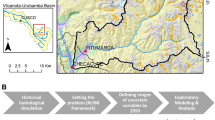Abstract
The degradation of water resources by diffuse pollution, mainly due to nitrate and pesticides, is an important matter for public health. Restoration of the quality of natural water catchments by focusing on their catchment areas is therefore a national priority in France. To consider catchment areas as homogeneous and to expend an equal effort on the entire area inevitably leads to a waste of time and money, and restorative actions may not be as efficient as intended. The variability of the pedological and geological properties of the area is actually an opportunity to invest effort on smaller areas, simply because every action is not equally efficient on every kind of pedological or geological surface. Using this approach, it is possible to invest in a few selected zones that will be efficient in terms of environmental results. The contributive hydraulic areas (CHA) concept is different from that of the catchment area. Because the transport of most of the mobile and persistent pollutants is primarily driven by water circulation, the concept of the CHA is based on the water pathway from the surface of the soil in the catchment area to the well. The method uses a three-dimensional hydrogeological model of surface and groundwater integrated with a geographic information system called Watermodel. The model calculates the contribution (m3/h or %) of each point of the soil to the total flow pumped in a well. Application of this model, partially funded by the Seine Normandy Basin Agency, to the catchment of the Dormelles Well in the Cretaceous chalk aquifer in the Orvanne valley, France (catchment area of 23,000 ha at Dormelles, county 77), shows that 95 % of the water pumped at the Dormelles Well comes from only 26 % of the total surface area of the catchment. Consequently, an action plan to protect the water resource will be targeted at the 93 farmers operating in this source area rather than the total number of farmers (250) across the entire 23,000 ha. Another model, developed from Epiclès© software, permits the calculation of the under-root nitrate concentrations for each field based on soil type, climate, and farming practices. When the Watermodel and Epiclès© are coupled, nitrate transfers from the soil to the catchment and the river can be modeled. In this study, the initial pollution due to the actual farming practices was simulated and we were also able to estimate the efficiency of the agronomic action plan by testing several scenarios and calculating the time needed to reach the target nitrate concentration in the well.

















Similar content being viewed by others
References
Assemblée nationale (2010) Arrêté du 21 janvier 2010 modifiant l’arrêté du 11 janvier 2007 relatif au programme de prélèvements et d’analyses du contrôle sanitaire pour les eaux fournies par un réseau de distribution, pris en application des articles R. 1321-10, R. 1321-15 et R. 1321-16 du code de la santé publique
BRGM (2009) La Banque du sous-sol : un capital pour l’environnement et la connaissance géologique
Emsellem Y, Pfister C, Millerliri A, et al (1994) La gestion active des aquifères à l’aide des modèles. BRGM, pp 89–95
Lacherez-Bastin S (2005) Contribution à l’étude de la migration des nitrates dans le sol et la zone non saturée de la nappe de la craie dans le Nord de la France : modélisation intégrée des nitrates dans le bassin versant de l’Escrebieux. Université Lille1 - Sciences et Technologies, France
Mégnien C (1970) Atlas des nappes aquifères de la région parisienne. BRGM, France
Parlement européen (1998) DIRECTIVE 98/83/CE DU CONSEIL du 3 novembre 1998 relative à la qualité des eaux destinées à la consommation humaine
Roux JC (2006) Aquifères et eaux souterraines en France
Vernoux JF, Wuilleumer A, Dörflinger N (2007) Délimitation des bassins d’alimentation des captages et cartographie de leur vulnérabilité vis-à-vis des pollutions diffuses
Author information
Authors and Affiliations
Corresponding author
Additional information
Responsible editor: Philippe Garrigues
Rights and permissions
About this article
Cite this article
Constant, T., Charrière, S., Lioeddine, A. et al. Use of modeling to protect, plan, and manage water resources in catchment areas. Environ Sci Pollut Res 23, 15841–15851 (2016). https://doi.org/10.1007/s11356-015-5459-6
Received:
Accepted:
Published:
Issue Date:
DOI: https://doi.org/10.1007/s11356-015-5459-6




